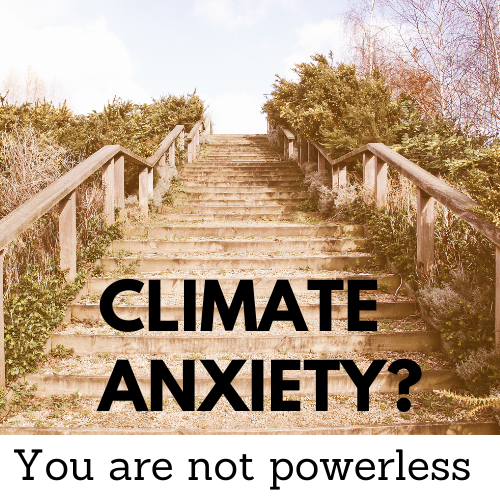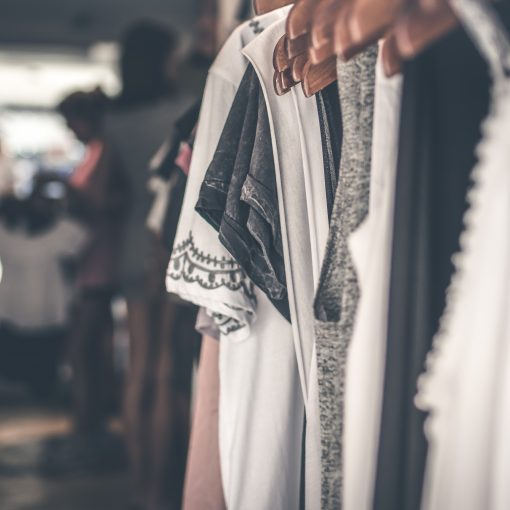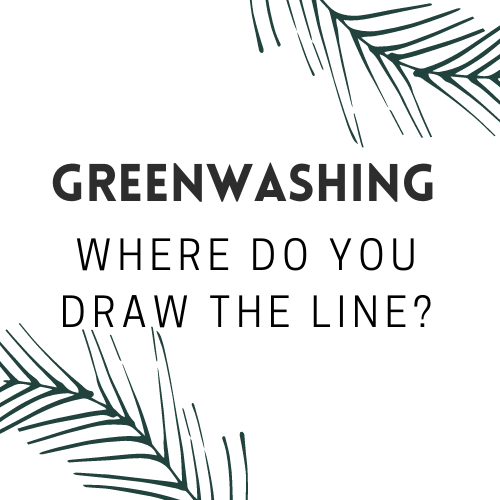
I look back at my past and I see many different moments that I am overly interested in wearing whatever others are wearing. In elementary and middle school years, I looked forward to that new set of clothes at the beginning of the year. In high school, the biggest past time was spent shopping. In college, if I didn’t have a stylish, comfy sweatshirt and sweatpants, why bother even studying? Even in my current professional life, I find myself thinking that I could look more professional if I just had “that”.
I don’t think I am alone. I also think when we find ourselves doing this, we hop online and find where we can find that new item. After all, it is “in” now, but if I wait too long, no one will be wearing it anymore.
This is what fast fashion is based around. The more you dive into the industry, the uglier it actually is. It is an industry creating an insane amount of clothing that will only be worn for a short amount of time. Even if you are not big on new clothes, you may find this concept applying to other items you buy often. Let’s dive in to fast fashion and figure out if we can reduce our contribution to the problem.
Fast Fashion Broken Down
The concept of fast fashion is providing new types of clothing designated as the “current trends”. It encourages consumers to go out and continually make new clothing purchases just to appear more “with the times.” This is done through lots of marketing, but also it has become ingrained in our society at this point. There is a whole genre of Youtube videos where men and women just show what they purchased.
The True Cost documentary notes that fashion trends used to go with the four seasons. Now, fast fashion companies divide up the year into 52 different seasons. With new styles coming in every week. No wonder many feel like they never have the newest cool style or trend.
How is Fast Fashion Unethical?

Garment Factories
You cannot talk about the garment industry without looking at the Rana Plaza disaster in 2013 in Bagladesh where 1100 people were killed when the building collapsed. The building’s condition was mentioned to management multiple times as workers noticed the cracks in the walls and even mentioned it the day of the collapse. This was not a singular occurrence. Unsafe working conditions lead to multiple large scale disasters in 2013 alone. In an article by The New York Times, they go onto explain that while some temporary improvements may have occured after, it is still an entirely broken system.
Again from The True Cost, in the 1960s, the USA used to make 95% of our own clothing. Today we make only 3% in the USA, everything else is outside USA. Bangladesh is one of the worlds largest collection of garment worker factories. The concern with this is that their labor laws are not anything close to what you would be okay to work in or would want your friends or family working in.
The large fast fashion companies contract out these garment factories. Many companies will state they ensure their production facitilies are safe and ethical, but then do nothing to prove this. The production timetables for each new clothing item require long hours by the workers with little pay and often very poor environments.
The cost and quality of this type of clothing is kept lower to encourage consumers to continually make the new purchases. When one chain is selling a tank top of $5, that means they need it created for $4. But then the next chain sees their competion selling for $5, so then they need to sell their’s for $4, so it needs to be made for $3. This means making cuts in terms of worker safety, salary, benefits, environmental safety, and public health safety.
Farmers
Farms become like these factories. It is harmful in different ways. Soil loses nutrients from the continual harsh chemicals which affects local communities in runoff of pesticides, among other ecological affects. In The True Cost, they discuss how increasing prices on farmers lead them further and further into debt. Then they get to the point that they lose their land due to being unable to pay for it, in which they were having unheard of amount of farmer suicides.
Fast Fashion Companies

Any clothing company that offers cheap clothing that changes on their racks multiple times a season is more than likely a fast fashion company.
- H&M
- Forever 21
- Zara
Slow Fashion Broken Down
The concept of slow fashion are companies that are responsible in what they produce from an ethical, environmental, and quality standpoint. They provide access to clothing that will last a long time. Having clothing that lasts longer is less resource intensive than constantly going toward the next trend. It also is a piece of mind knowing the workers were paid a fair wage and treated with respect. How sad that this is a revoluationary concept!
Benefits of Slow Fashion
Slow fashion is cheaper over the long run. Buying something that is considered slow fashion may cost more up front, but you are paying to ensure the people who created it were treated and paid fairly. The garment will also last longer and may even be able to be repaired if it is damaged. Every purchase we make is investing back into those companies. Let us ensure we are investing back into the right companies.
Producing clothes is incredibly resource intensive. The True Cost documentary explains that the textile industry is the second most polluting industry only under the oil industry.
Slow fashion doesn’t mean everyone wearing the same thing. It is surprising all the different styles you can find out there. Not to mention the option of shopping secondhand, in which there is an unbelieveable amount of options available due to so much clothing being made all the time.
Slow Fashion Companies
Clothing companies that work to produce quality pieces that are long lasting.
- Patagonia
- TenTree
- Organicbasics
- People Tree
Fair Trade Can Help
When it comes to finding products that combat fast fashion, fair trade is a term to keep an eye out for. Fair trade is a practice of corporate social responsiblity. Fair trade looks to ensure producers are paid fairly for what they provide. From the production, to harvesting, to manufacturing, everyone involved should be paid and treated fairly along with doing it in a way that is good for the environment. Transparency is also important to help ensure those promises are carried out upon.
There are companies that sell only fair trade items and there are certifications companies can get to help prove they are doing the correct things. Fair Trade Certified is one of those certifications.
A few Fair Trade Certified Brands:
- Patagonia
- Madewell
- Athleta
- J. Crew
- Aventura
Ways to Combat Fast Fashion
- Avoid the pull of trends
- Shop Secondhand
- Look for Fair Trade items
- Invest in quality items to last you a long time
- Repair items that become damaged when possible
- Try a capsule wardrobe to limit your clothing
- Stop following the fast fashion companies on social media and unsubscribe from their emails
- Follow ethical and sustainable influencers on social media
- Avoid brand new holiday specific clothing
- Clothing swaps with family or friends to mix up your wardrobe
- Borrow items from others for specific events
Conclusion
The world is not black and white. You will find companies that may be doing the right thing in some ways, but not in others. I encourage you to do some research when making new clothing purchases. Also keep in mind that you can find great options secondhand.
Clothing is not the only thing that falls under the fast fashion category. Think of items you cycle through quite a bit. Scarves, purses, shoes, bags, even home decor. There are things we continually purchase that often just are not needed.
We purchase so much the idea of researching into each of these companies before purchasing feels tedious. This is a great reason to purchase less. Less time spent researching countless things. You research once for the item, save up, then make the purchase that will last a long time.
I have gotten to the point that I am no longer “looking for the deal” when it comes to new clothing. I don’t want to buy a tank top for $5 when I know that it will only last a few washes. It should have taken more than $5 to collect the resources and produce it responsibly.
I say this from a position of privilege. I am able to go without certain items to save up and purchase the slow fashion item. I have the ability to look at thrift stores and secondhand options. I recognize that many do not have that, which is why I would never put someone else down for making the decisions they need to make.
I hope this was helpful to give you an overview of the fast fashion industry and how we can work to combat it. It is terribly frustrating that there are these incredible injustices. We do not see it on a daily basis, so it is easy to believe it does not happen. We can be a part of the solution though as people and companies help lead the charge to combat fast fashion.

Resources:
Why Won’t We Learn from the Surviors of Rana Plaza Disaster?
Additional Resources I recommend Checking out if you are interested in this topic:
The True Cost directed by Andrew Morgan. This is a fantastic documentary that left me feeling angry and sad, but also refocused on why this topic is important. I mentioned this documentary multiple times in this article in hopes you can check it out.
10 Tips to Create an Ethical and Sustainable Wardrobe by Rob Greenfield with Kamea Cheyne. This short Youtube video dives into ways to create a more conscious wardrobe. I really respect Kamea Cheyne. She creates one of my favorite podcasts, Green Dreamer.
Quitting Fast Fashion | how I transitioned to a sustainable wardrobe without $$$ & why by Sedona Christina. She is a large Youtuber on many areas of sustainabilty. This video not only introduces you to her channel, but dives into how it doesn’t need to be expensive to start having a more conscious




